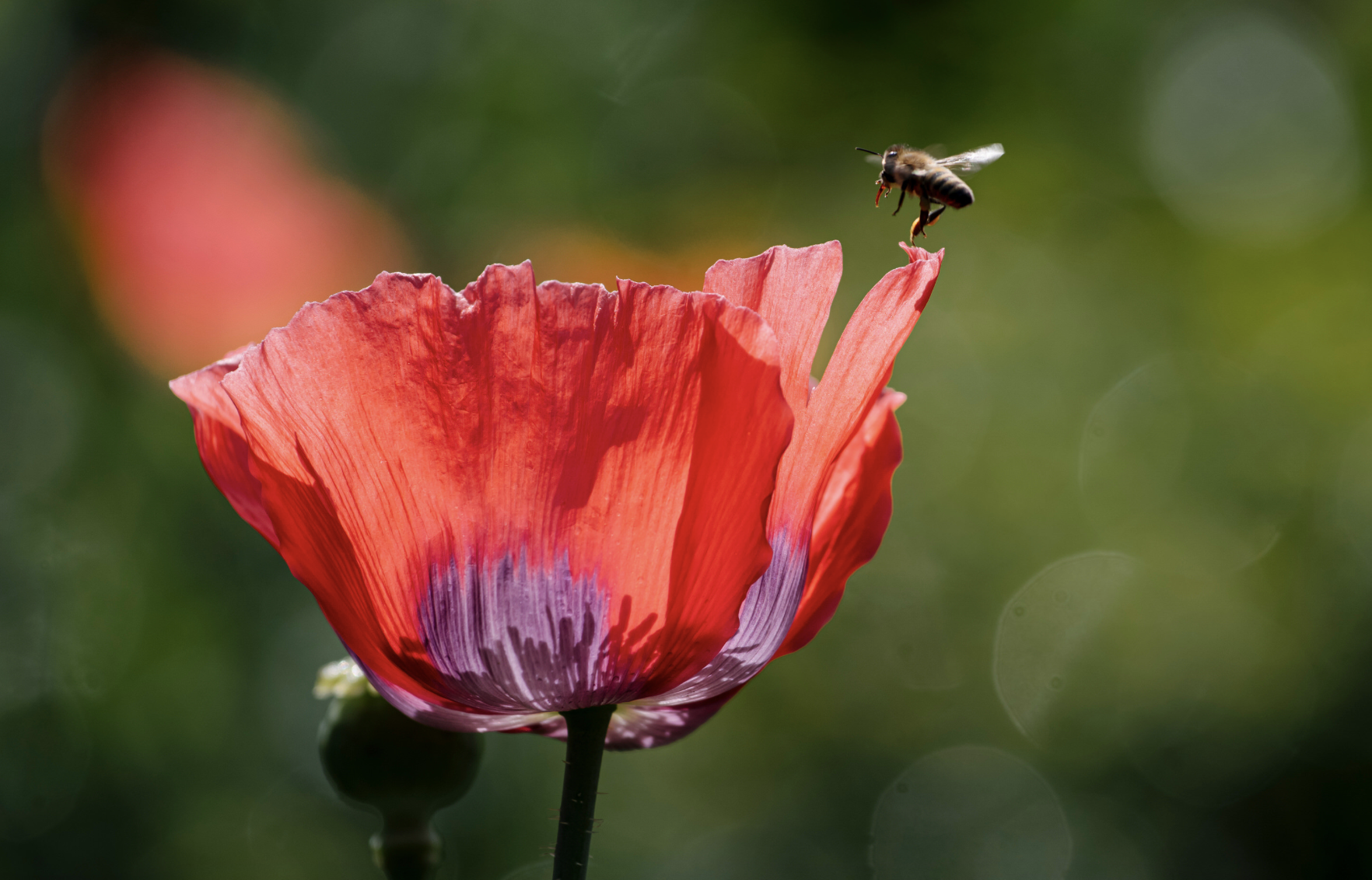Photo Credit: Liz Condo. Helen Yoest in her poppy field.
Photo Credit: Liz Condo. Bread poppy, Papaver somniferum, and honeybee
Long ago, a friend shared poppy seeds from her garden with me. I had no success that first year, but she believed in me and let me try again. As it happened, I went to the Montrose Garden's open day, and a staff member cleared a large area of leaves and mulch. She told me she was preparing the area to direct-sow poppy seeds. That was when I learned that poppy seeds need sunlight to germinate.
Photo Credit: Liz Condo
My first attempt failed because the seeds were sown over composted leaf mulch. The little valleys where the seeds escaped were enough to keep sunlight from reaching them. That was about 25 years ago. Today, I have so many poppies that I must pull them from the paths to journey through my garden.
Photo Credit: Poppy flowers, seed heads, and larkspur,
I often wonder how the poppies reseed so well without my help. The mulch is still there. I try not to dwell on it and enjoy the flowers. I love them as much as the bees love the flowers and the goldfinches love the seeds.
Photo Credit: Liz Condo. Peony, Paeonia lactiflora
In the front paths through the Food Forest, I’ve planted dozens of herbaceous peonies, Paeonia lactiflora, to line the way. Elsewhere in the garden, I have one tree peony, Paeonia × suffruticosa, and one Itoh peony, also known as intersectional hybrids, a cross between tree peonies and herbaceous peonies—'Bartzella'. Liz Condo missed the bloom time and I failed to get a pic. I’d like to get many more Itoh peonies, but need to wait for the prices to come down.
Photo Credit: Liz Condo
I have had a long history with my two clivias, Clivia miniata., 20 years, in fact! One pot bloomed for the first time five years ago,
Photo Credit: Liz Condo. Clivia miniata
in 2020 and again this year in 2025. The second pot of clivias bloomed for the first time this year!
Photo Credit: Liz Condo
I don’t think of myself as a patient person, but I guess I am. It helps the foliage is so lovely. Each winter, I bring them in. They are the only overwintering plants I don’t get sick of seeing a month before they can go back outside for the season.
Photo Credit: Creeping thyme, hymus serpyllum..
Years ago, I took back some lawn to plant four parterres with a center bed. I tried various plantings over the years, but I couldn’t find the right look until I considered creeping thyme, Thymus serpyllum. Satisfied now. The thyme is filling in nicely.
Photo Credit: Liz Condo. Autumn sage, Salvia greggii
I can’t remember seeing spigelia the first time, but once I did, I had to have it.
Photo Credit: Liz Condo. Indian pink, Spigelia marilandica.
Spigelia marilandica is endangered or imperiled in much of its native range of the southeastern United States. Since 2010, I’ve had this one clump. Clearly, it is not a spreader!
Photo Credit: Liz Condo. Spiderwort, Tradescantia virginiana
In 1988, when we moved into our first Raleigh home, I couldn’t help noticing spiderwort growing throughout the yard. Did you know, each individual flower only last a day?
Did you know, Ostrich fern fiddleheads are an edible spring delight? Not all fern fiddleheads are edible, containing toxins. The Ostrich fern has much lower toxic levels, are are safe to eat once cooked.
Photo Credit: Liz Condo. Foxglove, Digitalis purpurea.
It’s only been in the last five years that I became enamored with foxgloves. I’m not sure what took me so long, since I do appreciate the flowers and what they provide. Their nectar-rich flowers attract pollinators like bees, butterflies, and hummingbirds, supporting biodiversity and ecosystem health. I may plant more later in the year.
Until soon,
Naturally, Helen Yoest













